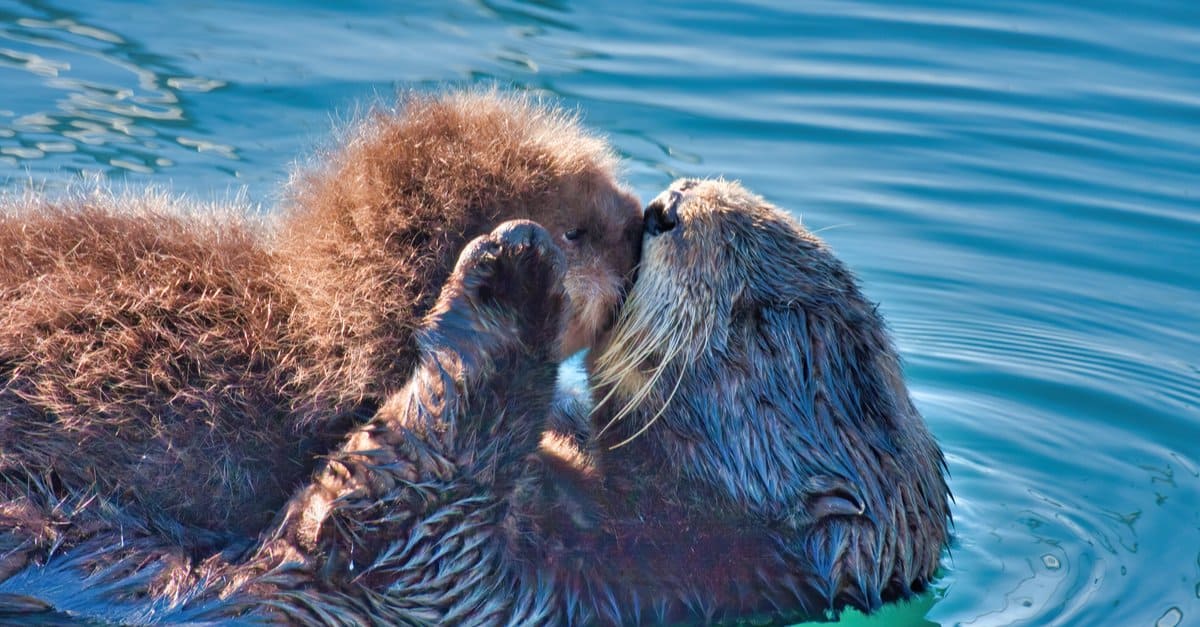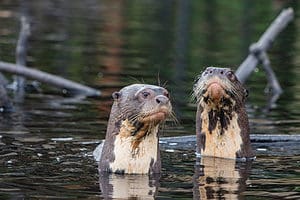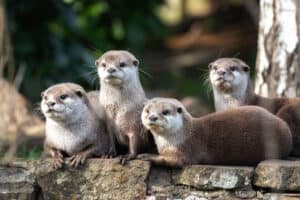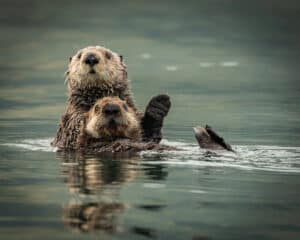Otters are adorable creatures that triple in cuteness when they become mothers. Their young, called pups, are the definition of cute. As all good mothers are, otters are ferocious when it comes to protecting their young. They are capable of doing serious damage if you happen to make a mother otter nervous and find yourself at their sharp and pointy “danger” end.
As much as the world loves these normally laid-back floaters, no one seems to know very much about them. In this article, we will explore some little-known facts about otters and their families.
1. Why Do Female Otters Have Scars On Their Noses?
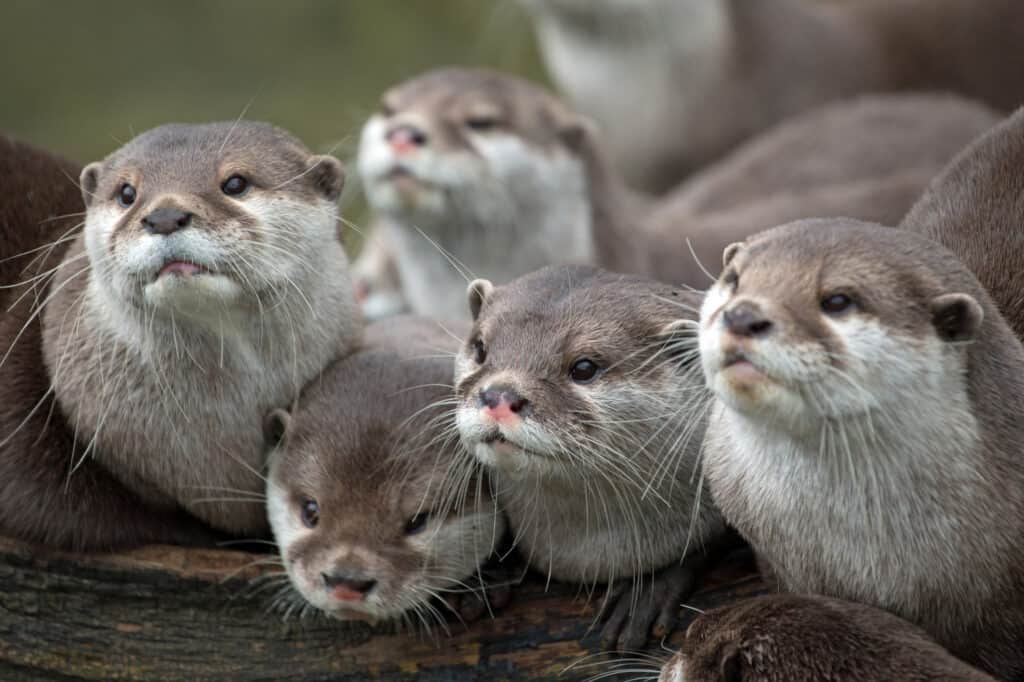
Three female otters in this photo show pink scars on their noses from the past violent male mating rituals.
©L-N/Shutterstock.com
Otters are known for their adorable water antics, but they have some rather violent ways of creating more otters. To put it frankly, they engage in some very rough mating rituals. Some female otters are missing chunks of their noses. The scars are generally pink and very obvious.
For otters, foreplay looks a bit like goofy but hardcore training for the Otter Water Olympics. They can be seen lunging, swimming, diving, twisting around one another, and of course, biting. The male otter bites the female on the back of the neck and, of course, the nose. This will go on until the female is receptive. After they have finished mating, the two will frolic and play in and out of the water.
2. The Darker Side of Otter Love
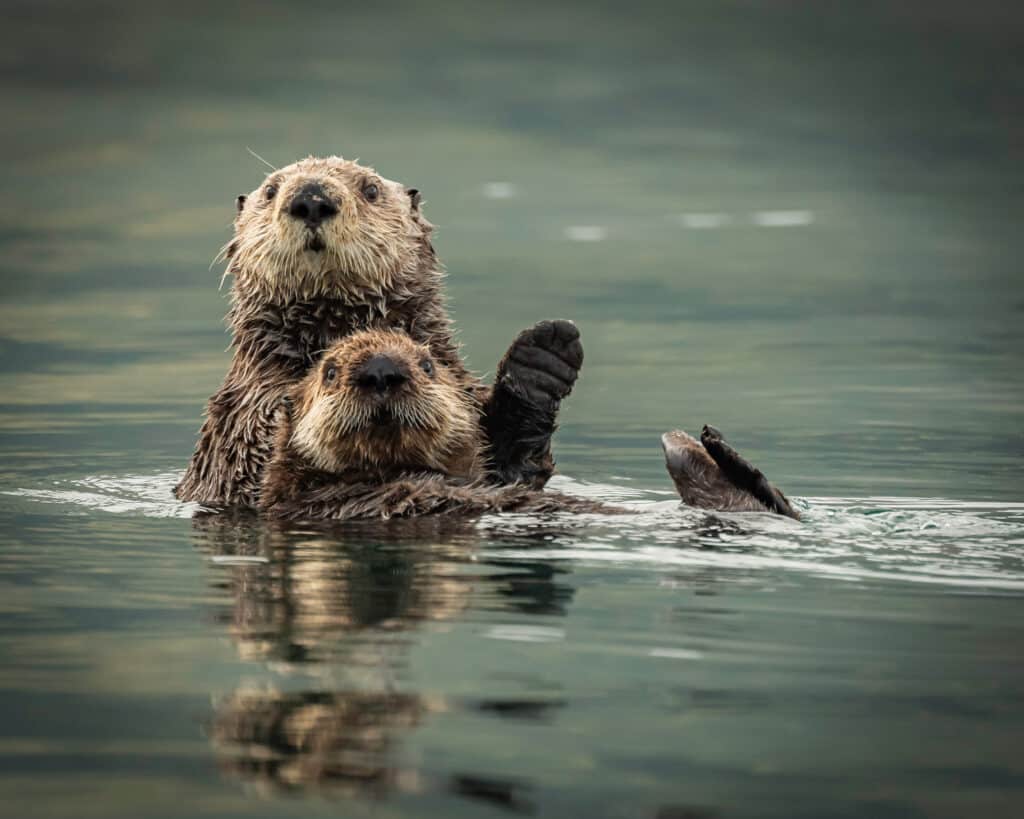
Though it seems disturbing to humans, it is just a part of otter life.
©Laura Hedien/Shutterstock.com
Sometimes the male otter bites the nose of the female otter, and they spin together underwater until she dies from her injuries or he drowns her. He will then mate with her corpse anyway. Sometimes he will even go so far as to drag her corpse around for a while, guarding it and mating time and time again. That’s not all.
Male otters have been viewed dragging a seal pup into the water and performing the violent mating ritual. The seal pup was forcibly mated with and drowned because the otter held it under the water for so long. The male otter then began grooming himself like nothing had happened, and he didn’t just force a baby of another species to mate and then murder it. Dark, right?
3. Male Otters Kidnap Pups

Though this is alarming, many other males in the animal kingdom do very similar things.
©Chase Dekker/Shutterstock.com
We aren’t quite finished with the disturbing facts about male otters. Another strange and rather evil thing they do is to kidnap the pups of the mother otter and hold them ransom until she brings him food.
As a biologist described it, a male otter will trap a pup in the water while the mother is diving to hunt. He then holds the pup underwater with the threat of drowning it. When the mother surfaces with food, the male otter steals it and lets her pup go. The mother and pup quickly make a getaway. That’s not far from a mother being attacked and her groceries stolen upon leaving the grocery store while her child is held captive by the assailant.
4. Otters Have a Pooping Dance
Yes, you read that right. Otters do have a pooping dance ritual, and it’s hilarious. As you have seen in the above video, they dance, and it’s cute and weird at the same time if an animal can be cute while pooping. What makes this video even funnier is the fact that these two buddies had to poop at the same time, in the same place. They truly are social animals! But WHY do they repeat this odd ritual every time they need a potty break?
These silly and sinister creatures have a pooping ritual near the water. The males groom each other before and after they do their business; it’s a bit like washing their paws. The males also tend to hang around the bathroom called latrines. They spend time chatting it up with their buddies and sniffing the bathroom spots of other otters to find out more about them. They build bonds with other otters and spend time playing and grooming each other.
The weird dude behavior does have its positive attributes. When each otter uses the bathroom, the male otters can sniff and see if the otter is sick, if they are feeling happy or sad, if they are ready to have babies, and so forth. This note-leaving behavior is helpful and stops them from brawling over ladies and food. This bathroom etiquette helps mothers with pups stay safe and informs males of each other’s boundaries and status. It is like otter social media.
5. Sea Otters are Polygynous
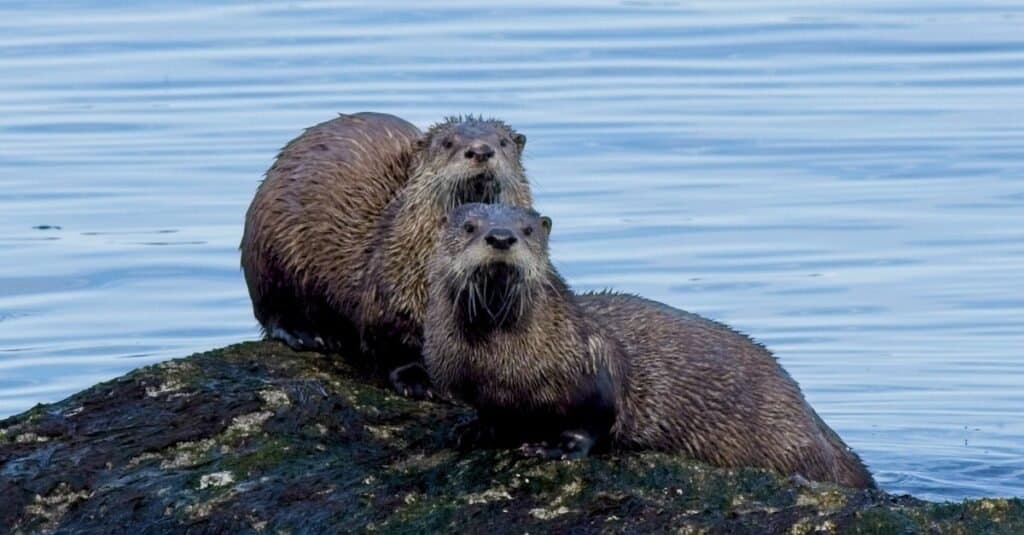
River otters, in particular, are known to be monogamous and typically stay loyal to one partner during their lives. On the other hand, sea otters are polygynous.
©iStock.com/pr2is
Once again, the topic of conversation is the male otter. Male sea otters are polygynous, meaning they sleep around, and it’s just part of nature. They generally have several females they mate with when the time is right. River otters are supposedly more sincere and choose one mate to spend their lives with. After a bit of research on the topic, it seems that the southern river otter is also polygynous. They also choose another mate if their partner dies.
There are 13 types of otters in the world, and eight of those species are thought to be polygynous. The other five are thought to be monogamous. Of all the otter types, the only otter to mate for life and not choose another partner if their mate dies is the small-clawed otter. Both the Northern river otter and the sea otter are the only otters found in the US and are polygynous.
The polygynous otters tend to live different lives than monogamous otters. Polygnous otter males are solitary animals that are not involved in helping raise the pups, collecting food, or building the nest. They stay away from the female otter until it is time to mate again. The females in polygynous groups stick together and form close bonds. Together they hunt, build nests, offer protection, and raise pups as a community called a raft. The rafts can contain over 100 otters at a time! Males also have rafts and can have even higher member counts than female rafts.
On the other hand, monogynous otter couples spend their time together as a family. The male helps hunt, helps build the nest, and helps raise the pups along with the female. This is a nice thought, but many monogynous pairs do not co-parent, and the task of raising the young is 100% dependent upon the mother.
6. Otters Dig the Social Scene

Being an introverted otter would be very difficult to maintain.
©iStock.com/Mirko_Rosenau
Otters are incredibly social animals. Rarely, they are ever aggressive. That only seems to happen when they’re mating for some reason. The rest of the time, these long silly beings are playing on land or in water. Some of their antics are running and chasing each other, jumping, doing somersaults, wrestling, grooming one another, swimming, belly flopping, and diving together. They even make waterslides and shuffle rocks together. Shuffling rocks seems to be their way of juggling.
7. Mother Otters are Single Moms
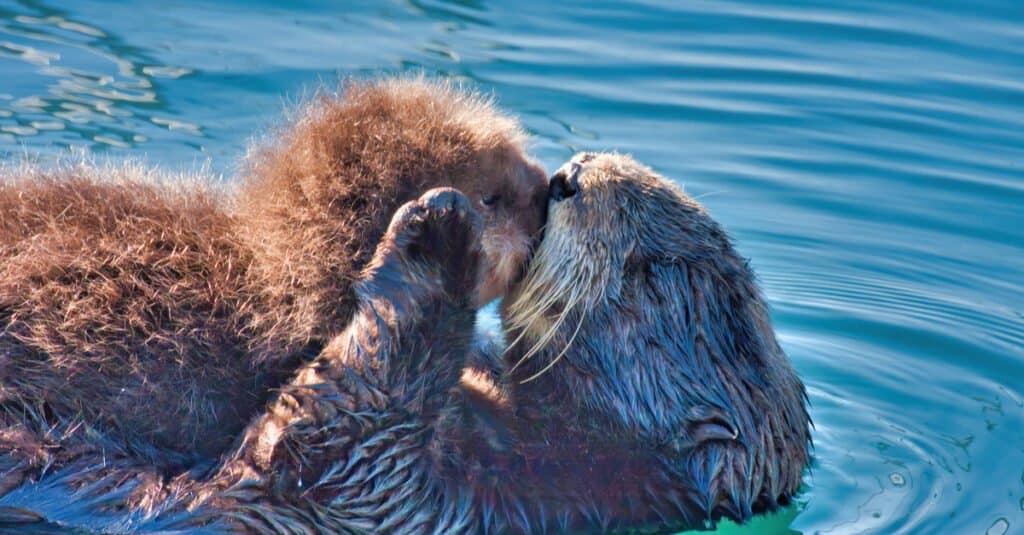
A mother otter has a very close bond with her pups.
©Manuel Balesteri/Shutterstock.com
Mother otters don’t always have help from the paternal side of the family. Especially if the relationship is polygynous. Sometimes the male otter in a monogamous relationship will pitch in and take over some of the parental duties like hunting, nest building, guarding the nest, and caring for the pups.
Other times, it is solely up to the mother otter to do it all, just as a single mom would. This is certainly not an easy feat if the otters are monogamous because the female may not have a raft of ladies waiting to pitch in and raise their young together. In polygynous relationships, the females have a large raft of other females and nursing mothers who form close bonds and work together as a community to raise their young. Since it is a large group, it also offers protection from males who are looking to cause trouble.
When a mother otter is on her own and needs to hunt, she will hide her pups. A mother sea otter blows air into her pup’s fur to create a life jacket next to its skin. This keeps the pup warm and helps it to float on top of the water. Pups cannot swim at first, and this enables the mother to wrap the baby in kelp so it does not float away while the mother otter quickly hunts.
8. Otters and Ferrets are Cousins

Ferrets are long and silly, but some of their cousins are dangerous predators.
©iStock.com/Tatyana Consaul
Otters are in the Mustelids family, which is the largest family in the suborder of Caniformia of the order Carnivora, with about 66 to 70 species in nine subfamilies. You could say they have an extremely large family. The Mustelids are carnivorous creatures with sharp teeth and elongated bodies. They can be small or large and are very diverse in their appearance and disposition. One characteristic they all share is their heightened intelligence and emotional bonds with their young.
In the massive family are otters, ferrets, badgers, martens, minks, wolverines, polecats, sables, grisons, tayras, stoats, and even the honey badger. Most of these creatures are small, long, and thin. They are extremely good hunters and protectors of their dens, food, and young. Some of the animals in the family are savage and extremely powerful, like the honey badger and the wolverine. Weasels are some of the best hunters in the animal kingdom.
9. Otter Species are Incredibly Diverse
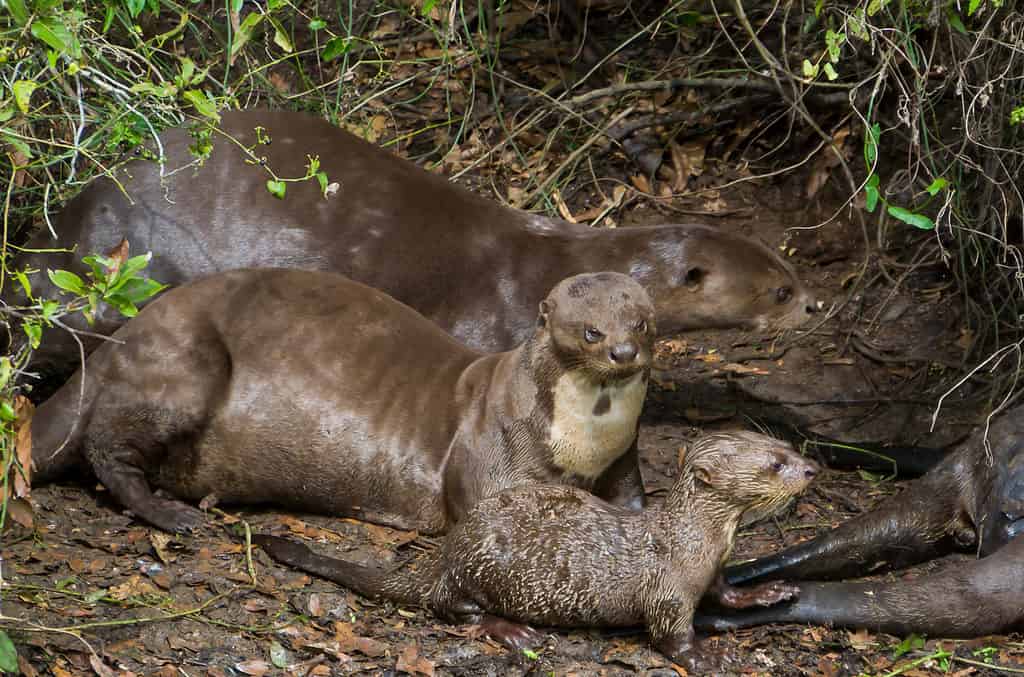
Giant river otters can grow to seven feet long!
©ThiagoSantos/Shutterstock.com
The otter family is very diverse. Some are small, fluffy otters that look adorable. Others are enormous and a bit scary. Some swim in the ocean, while others stick to rivers. There are 13 different types of otters in the world. Here is a list of the 13 species of otters; Eurasian Otter, North American River Otter, Neotropical Otter, Marine Otter, Southern River Otter, Congo Clawless Otter, Smoothed-Coated Otter, African Clawless Otter, Sea Otter, Hairy Nosed Otter, Giant River Otter, Asian Small-Clawed Otter, and Spotted-Necked Otter.
Below, a few of the otter types are spotlighted with some information about them. If you are interested in learning more, please visit our otter pages at A-Z Animals and the International Otter Survival Fund.
Sea Otter (Enhydra lutris)

©nvphoto/Shutterstock.com
The sea otter can measure up to six feet long. They are endangered and can only be found in the Southern US, Russia, Alaska, and British Columbia. They eat crabs, abalone, clams, starfish, and many others.
Hairy-Nosed Otter (Lutra sumatrana)

A hairy-nosed otter, a semiaquatic mammal endemic to Southeast Asia.
©Wirestock/iStock via Getty Images
The hairy-nosed otter can grow to be four to four and a half feet long. They are endangered and can be found in Vietnam, Cambodia, Thailand, Indonesia, Malaysia, Myanmar, and Laos. They eat snakes, shellfish, crabs, crawfish, amphibians and birds.
Giant River Otter (Pteronura brasiliensis)
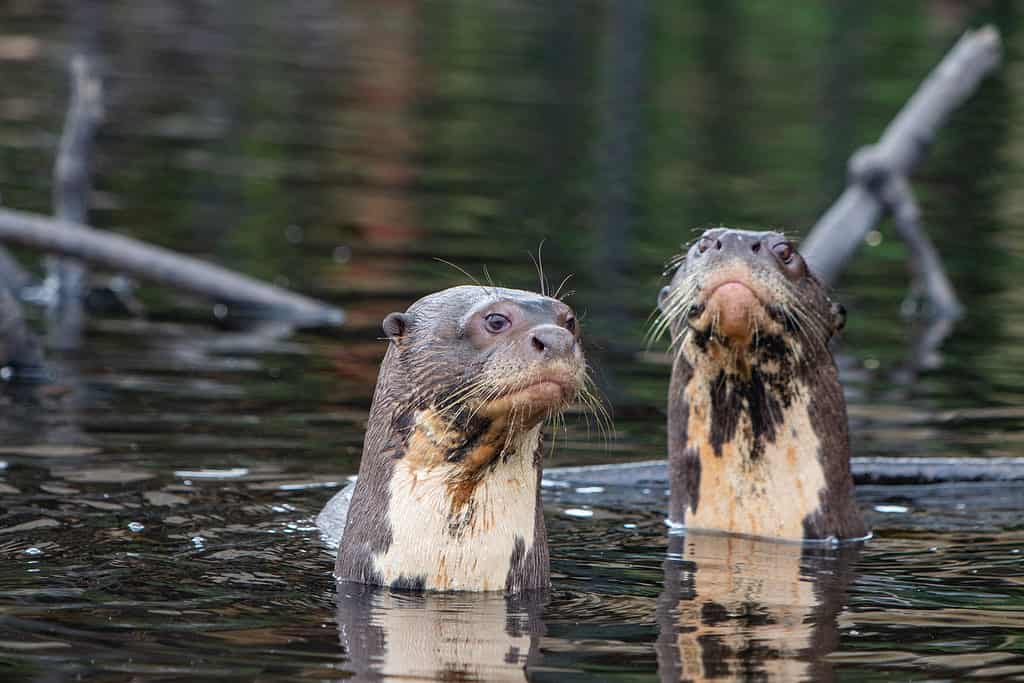
Giant otters can grow to seven feet in length!
©Johnny Giese/Shutterstock.com
The giant river otters are the largest species of otter and can grow to be up to seven feet long. Like many types of otters, they are seriously endangered. They can be found in Colombia, Brazil, Peru, Ecuador, Bolivia, Paraguay, and Venezuela. They are extinct in Argentina and Uruguay. These otters eat primarily fish, mainly characins, which are closely related to piranhas. The otters will also consume frogs, anacondas, and small caiman!
Asian Small-Clawed Otter (Aonyx cinereus)
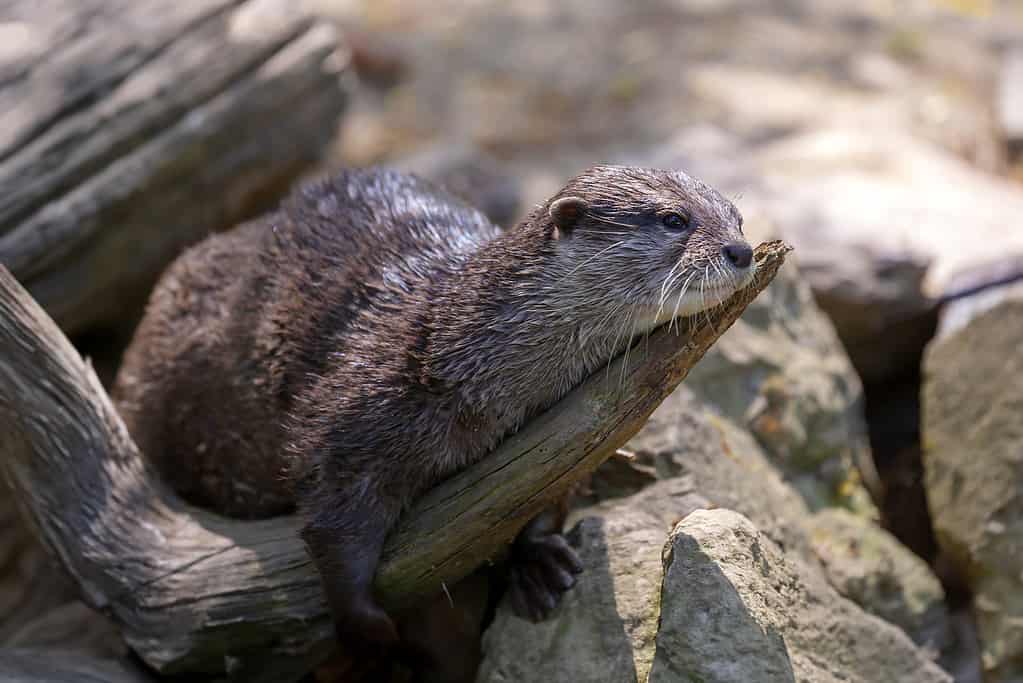
Asian small-clawed otters are the smallest otters.
©Jana Krizova/iStock via Getty Images
The Asian small-clawed otter is indeed small since it ranges between two and three feet long. These little otters are vulnerable but not endangered. They can be found living in Southern China, Southern India, Indonesia, the Philippines, and most of Southern Asia. Their diet consists of crabs, mollusks, and other organisms on the river bed.
Spotted-Necked Otter (Hydrictis maculicollis)
Spotted-necked otters are three to three and a half feet long. Their conservation status is near threatened. The otters live in Central to South Africa in lakes and rivers. Specifically, they can be found in Lake Victoria and across Zambia. These otters eat fish, amphibians, and crustaceans.
10. Otters are Fantastic Swimmers
Whether they are swimming on a solo hunting mission or spinning and diving with their friends, there is no argument that otters are some of the best swimmers out there!
11. Otters are Extremely Intelligent
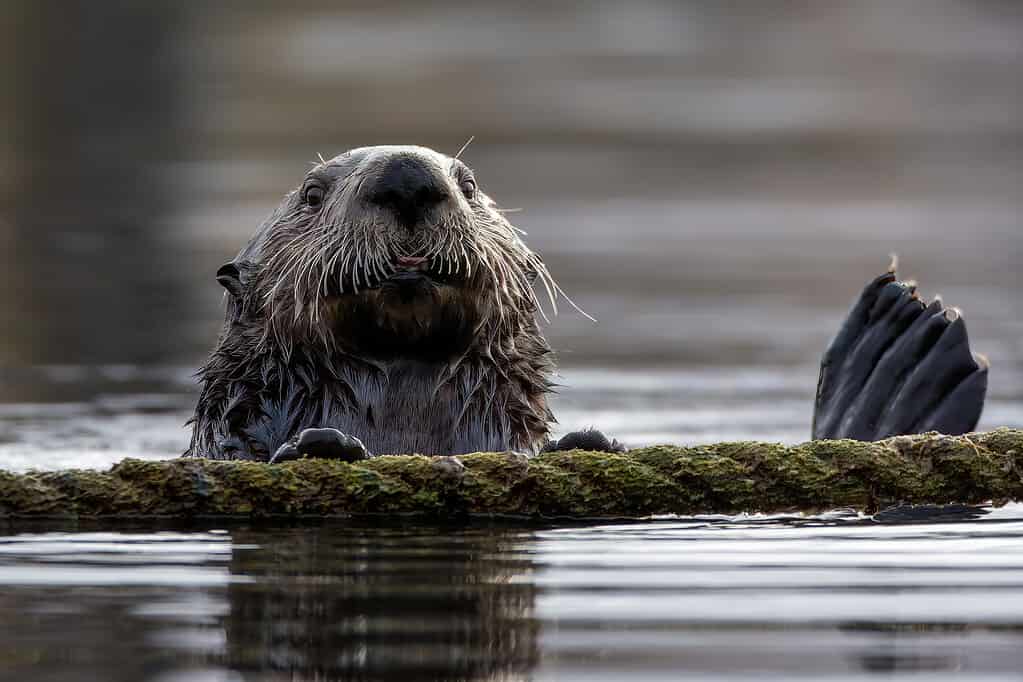
Otters have well-developed intelligence that is used for hunting, friendships, finding mates, and raising young.
©Kyle Moon/ via Getty Images
All otters are very intelligent animals, just like the many other species under the Mustelid family. They might be small, but what they lack in size, they make up for in brains. Otters are one of the only animals that use tools. They don’t just use random objects, either. They carry their favorite, most efficient tools under their arms in small protected areas behind flaps of skin. Their emotional intelligence is also off the charts. The bonds formed between them are much like human relationships between friends, lovers, and children.
12. Otters Keep a Favorite Rock with Them in a Pocket
It is widely understood that otters of all types carry a favorite rock along in their underarm flaps. Not every otter has a favorite rock, though many do. They choose this specific rock due to its usefulness, not for its beauty like humans might. Otters use these rocks to beat on clams and pry them open. They use them on other prey and even juggle them at playtime. They truly are unique animals.
13. Otters Make Amazing Mothers
Mother otters are very attentive and caring mothers. Mother river otters carry their pup on their stomach so the pups can nurse while mom looks out for trouble. They blow air into their pup’s fur to help them stay afloat while she hunts. It not only acts as a life jacket but also as a way to keep the pup warm and dry while in the water. Otter pups are born without the ability to swim, so mother otters spend lots of time teaching them once they are old enough.
14. Otters Use Tools
As discussed above, otters use rocks to open clams. Many times they even have a favorite rock that gets carried in an underarm pouch for easy access and to make sure their special rock doesn’t get lost.
15. Otters Really Like to Play
Through play, otters can practice important skills like running, hiding, diving, swimming, and grooming. The young otters learn how to search for food, what to do with it once they find it, and a ton of social skills. Without play, otters would likely become depressed and stop eating and caring for themselves. Play is important to hierarchy, as well. When a group of males or females play, they establish who’s who in their group.
16. Otters Have the Thickest Fur in the World
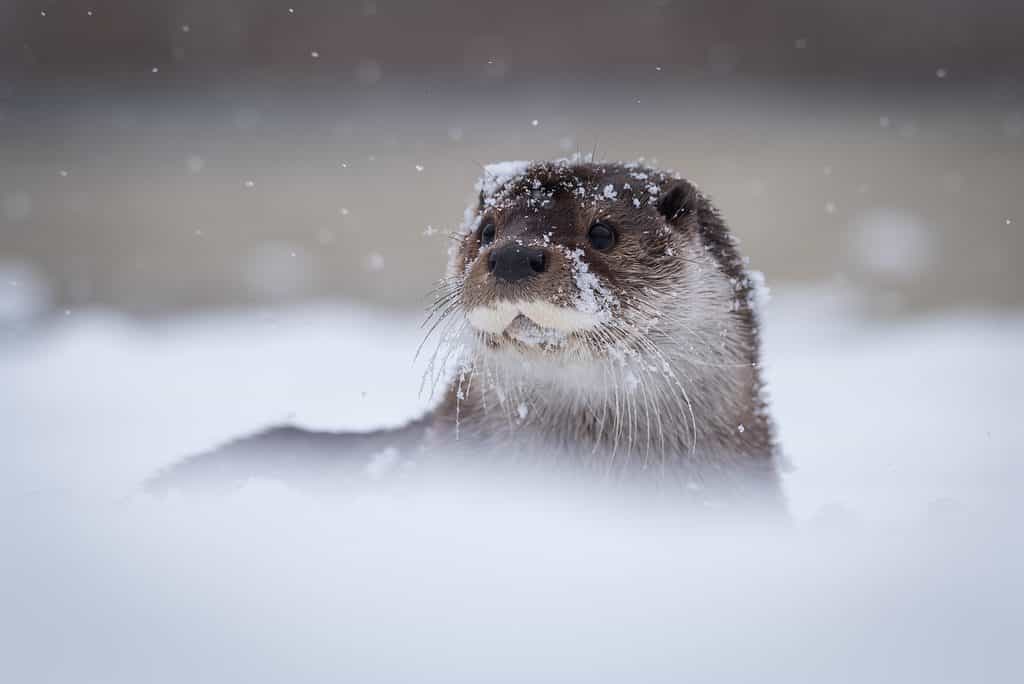
The fur of an otter is thicker than any other animal, even a
polar bear
!
©Tatyana Step/Shutterstock.com
Yes, you read that right. They do have thicker fur than any other animal. The fur of a sea otter has 600,000 – 1,000,000 hair follicles per square inch. Instead of blubber, these animals have extremely dense fur that repels water and holds in their body heat. Humans have roughly 100,000 hairs on their heads. This is one of the top reasons these animals are endangered. At the turn of the 19th Century, the fur trade claimed the lives of the sea otters in the Pacific Northwest. In the 1960s, conservation efforts took sea otters from Alaska and released them along the Washington coast. The numbers have held steady to this day.
17. Otters Can Hold Their Breath Longer than You Can
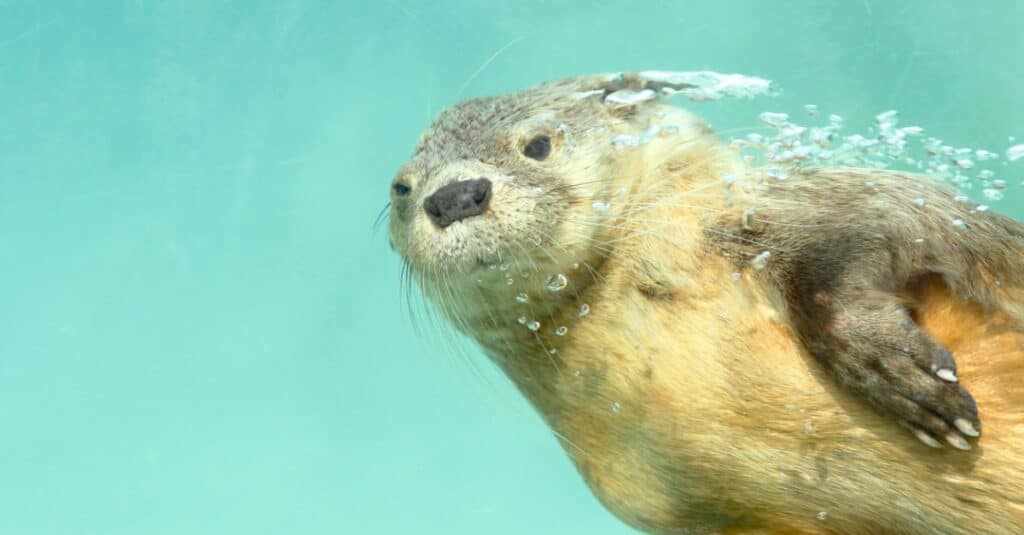
An otter has 2.5 times the lung capacity of other animals of a similar size and weight.
©Jonathan Chancasana/Shutterstock.com
A sea otter can hold their breath underwater for up to five minutes. That’s impressive, but what’s even more impressive is the eight minutes that river otters can hold their breath. Another mindblowing piece of their swimming abilities is that river otters can dive 60 feet in mere seconds. The sea otter can dive up to 250 feet beneath the surface and, once down there, will use their adorable and highly sensitive whiskers to scour for snacks hidden in rock crevices. It would be a bad time to be a dinner option for an otter!
18. Otters Are a Very Important Part of the Ecosystem
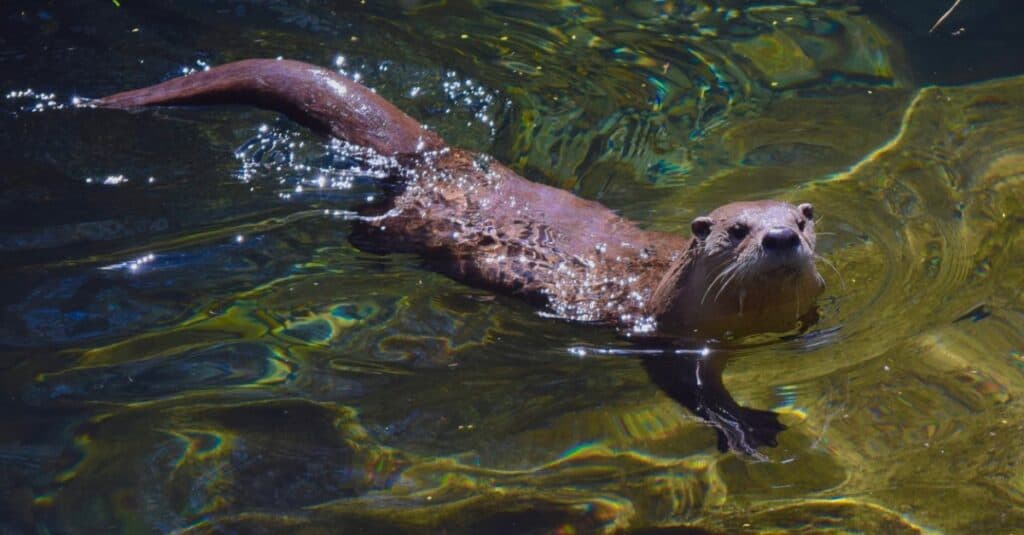
River otters can spend as much time on land as they do in the water.
©iStock.com/Kathryn Farley
Otters are what is called a “keystone species.” That means that without otters, the ecosystem would collapse. Sea otters keep the sea urchin population in check. Without them doing so, the sea urchins would overgraze on kelp and kill the massive kelp forests. Kelp plays a big part in keeping the oceans healthy by absorbing carbon. With less carbon in the oceans, the temperature does not warm as much, and the acidification of the ocean isn’t as bad as it could be.
On the other hand, river otters will not swim in polluted waters, and this helps conservationists know when a watery habitat has become unhealthy. Once the water becomes healthy, otters return to it. They also play an important role in maintaining healthy population numbers of the creatures they prey on that call the river home. What it all boils down to is without otters, the world wouldn’t be a very nice place.
Thank you for reading! Have some feedback for us? Contact the AZ Animals editorial team.

